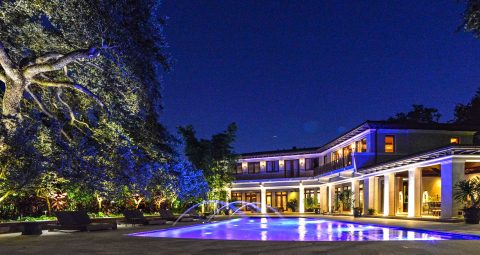Add drama and security with outdoor lighting

Outdoor lighting can create drama and increase the number of hours a yard can be used after the sun goes down. “The key goals for outdoor lighting are safety, security and aesthetics,” said Deena Bell, a landscape architect in Miami and owner of a company that carries her name.
Landscape lighting can add value to a home, said Hillary Hertzberg, a luxury real estate sales associate with Coldwell Banker Residential Real Estate’s The Jills. “It creates a dramatic effect and differentiates the property from others in the marketplace,” she said. “In the luxury segment, it is becoming an expected element rather than a bonus feature.”
LEDS FOR EVERYTHING
LEDs have changed outdoor lighting significantly. Over the past few years, they have improved a great deal in brightness and color, and they cost much less to operate than traditional lighting. “Everything is LED now,” said Thomas Crowley, owner of Paradise Landscape Lighting in Fort Lauderdale. “They take less maintenance, and they’re so economical, you can run them from dusk till dawn so you have security all night long.”
Because LEDs are so cost effective, they make motion sensor safety lights unnecessary, Bell said. “And motion sensor lights will compete with landscape lighting,” she added.
LEDs also make creating the design easier.With traditional low voltage lighting, the number of lights that could draw power from a single source was quite limited. Not with LEDs. “You used to have to balance a system so you had approximately the same voltage on each fixture,” said Robert Shomer, owner of Nightscapes in Fort Lauderdale. “But LEDs use low wattage so they have very little impact on the system and the fixture itself, and you can operate a wide range of voltages.With LEDs, you can start by lighting some main features and then if you need more lighting, go back and add some.”
Some homeowners still use traditional low 12-voltage lighting. If the choice is a high 120-voltage system, the wires must be buried under the ground. Municipalities differ in how deep into the ground they must be placed.
START WITH A PLAN
 When installing outdoor lighting, begin with a plan. “First do an inventory of the landscape you’ll be highlighting,” Bell said. “Choose trees and palms with shape and character that are interesting to look at. If you need to add more landscaping, do it before you do the lighting system.”
When installing outdoor lighting, begin with a plan. “First do an inventory of the landscape you’ll be highlighting,” Bell said. “Choose trees and palms with shape and character that are interesting to look at. If you need to add more landscaping, do it before you do the lighting system.”
“It’s important to have the right intensity and beam width,” Crowley said. “They depend on the height of the plant and the amount of foliage.”
“You don’t want too much brightness, or too little,” Shomer said. He suggests taking a 12-volt battery pack and experimenting with different brightness and intensity before investing in actual fixtures.
When possible, hide the fixtures themselves. “I don’t want to see the sources of the light,” Shomer said. “I want to see what the light is illuminating.”
UP OR DOWN?
Landscape lighting may include both up-lighting and down-lighting.When a tree has a large canopy, Bell likes to put lights up into it that will shine down on the leaves. “It looks like moonbeams coming through the foliage,” she said. “But a tree needs to be mature to moonlight properly. A tree with thick, leafy branches is the best candidate.”
When a wide-canopy tree is to be up-lighted from below instead, it may take more than one fixture. “If it’s a large oak, we might put two or three in different positions around the tree,” Crowley said.
For a tall palm on the other hand, a single narrow beam that starts on the ground and goes up the trunk may the right choice, Crowley said.
If a palm is very tall, it may be a good idea to mount a fixture partway up the trunk, Bell said. “We put it up high enough so the light reaches the underside of the canopy.”
IN-GROUND OR ABOVE GROUND
To light a wide expanse of lawn, choose fixtures that are mounted flush with the ground, Bell said. “You can walk on them or drive the lawnmower over them,” she said.
A multi-directional fixture that can be tilted different ways can also be a good choice for lighting the lawn. “It lights softly,” Crowley said. “By changing the angle and moving it up a quarter inch or so, you can make the light spread another two or three feet.”
For path lighting to illuminate walkways, aboveground stakes that shine down may be the best fixtures. “Since you’ll see them, choose decorative ones that go with your architecture,” Bell said.
“We put the stakes adjacent to the walkway and place them eight to 10 feet apart,” Crowley said.
WASHING A WALL IN LIGHT
Some homeowners choose to light the entire front or back facades of their homes.This can be aesthetically pleasing and also provides security. “We wash the whole wall softly in light,” Bell said.
Others want to highlight just a column or some other feature at the front door. “We’d use a small beam for that,” Crowley said. “The secret to beautiful lighting is to put the right beam with the right intensity.”
What’s right for a wide target such as a row of bamboo? “A high intensity wide beam,” Crowley said. “You don’t want any hot spots.”
Colored light can be created simply with lens covers, Crowley said. “You don’t need a complicated system on your iPad,” he said. “But we recommend using color only for special events. For the rest of the time, we recommend a soft, warm white.”
Buy quality fixtures. Crowley recommends aluminum, or brass for areas near saltwater. “Brass will discolor, but it will hold up longer than aluminum.”
Return to News
